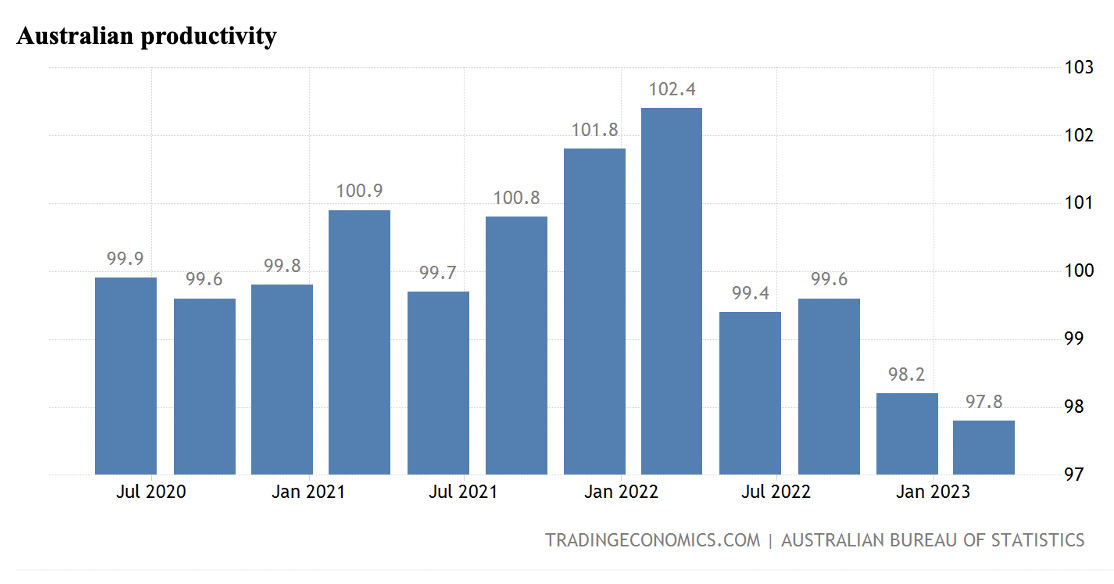

In April, theguardian.com website reported that one-third of workers were thinking about quitting their jobs, but recent train transport data from Sydney’s Wynyard station has shown that there has been a notable spike in employees coming back to the office.
This chart shows the comeback of workers to Sydney’s CBD.

These two trends make you wonder if the Reserve Bank’s excessive interest rate rises and this rising recession talk is encouraging a change of attitude for some employees.
What might be the basis of an interesting academic economic/sociology paper could be based around the fraction of one-third. You see, we’ve long been told that one third of Australians have a mortgage, so two-thirds are living in rented digs or reside in a place with no home loan debt over it.
In April, I could believe some people working from home could have been in the group toying with the idea of changing jobs, but you have to wonder if the increased number of economists worried about Australia falling into a recession is leading two new developments.
First, it’s making many employees wonder if their job could be on the line. And second, it’s making them think that those who come to work might be the least likely to be cut from a business’s workforce?
Of course, as a former academic myself, you can’t rule out other factors that are influencing different employees’ actions to come back to work.
So, a third reason could be that the rise and rise of Artificial Intelligence (AI) and its potential threat to many exiting jobs could be making employees realise that it might be timely to show how relevant they are to their bosses and that the old saying “absence makes the heart grow fonder” might not apply when it comes to the workplace.
There’s a fourth reason for the drift back to the office and The Guardian story captured it with the following: “Sophie Fennelly was working in tech sales when the pandemic started. Initially, Zoom and Teams felt like a “lifeline”, allowing work to continue while many were told to stay at home. But as time went on, constant remote working began taking a toll on her mental health”.
Yep, some employees undoubtedly need the variety and the mental stimulus of interacting with others. Apple’s CEO Tim Cook says he wants to get his workers back as much as possible because he wants the fruits of the “in-person collaboration that is so essential to our culture”.
Finally, more workers are making CBD business owners and managers smile in their return because their bosses are ordering them back! NAB’s CEO Ross McEwan has ordered his executives back to the office, while other employees are using a hybrid employee model. Meanwhile at the CBA, a spokesperson told The Guardian that “Based on our insights and recent experiences, from mid-July, our office-based people will come into the office for at least 50% of their working time over the month.”
One thing we don’t know is whether working-from-home is good or bad for productivity, but that will be the basis of many academic inquiries in coming years. That said, the chart below shows some interesting messages.

Looking at the figures from 2020 (when the pandemic started) to early 2022, the trend was mainly up, reaching a peak reading of 102.4. But since then, it has been all downhill and all the 2023 numbers are down on the 2020 productivity stats.
Whatever it is — be it the pressure of rate rises making people know they need to keep their jobs, or the threat of AI or a possible recession, or even if it’s cabin fever of working alone at home or with some work-unfriendly kids at home, employees are coming back to work.
A University of Sydney management expert Professor David Hensher says commuting is very stressful on employees, so the new age of hybrid employment arrangements has been a plus for workers, and he implies for businesses as well. He argues: “We also know that half of the time saved on commuting is converted into work time that benefits the employer and they need to know that.”
On the productivity impact of going back to workers in the office five days a week, he is insistent that the new age work-from-home model is a plus. “I’m really worried that we could end up back into this pre-Covid office environment, which was more stressful, less satisfying and really made no difference to productivity gains,” Hensher said.
I wonder how many employers and employees agree with him?
One thing that I reckon is right is that if you have a mortgage or your job looks threatened by AI, working out what your boss wants and delivering it looks like a sensible strategy.